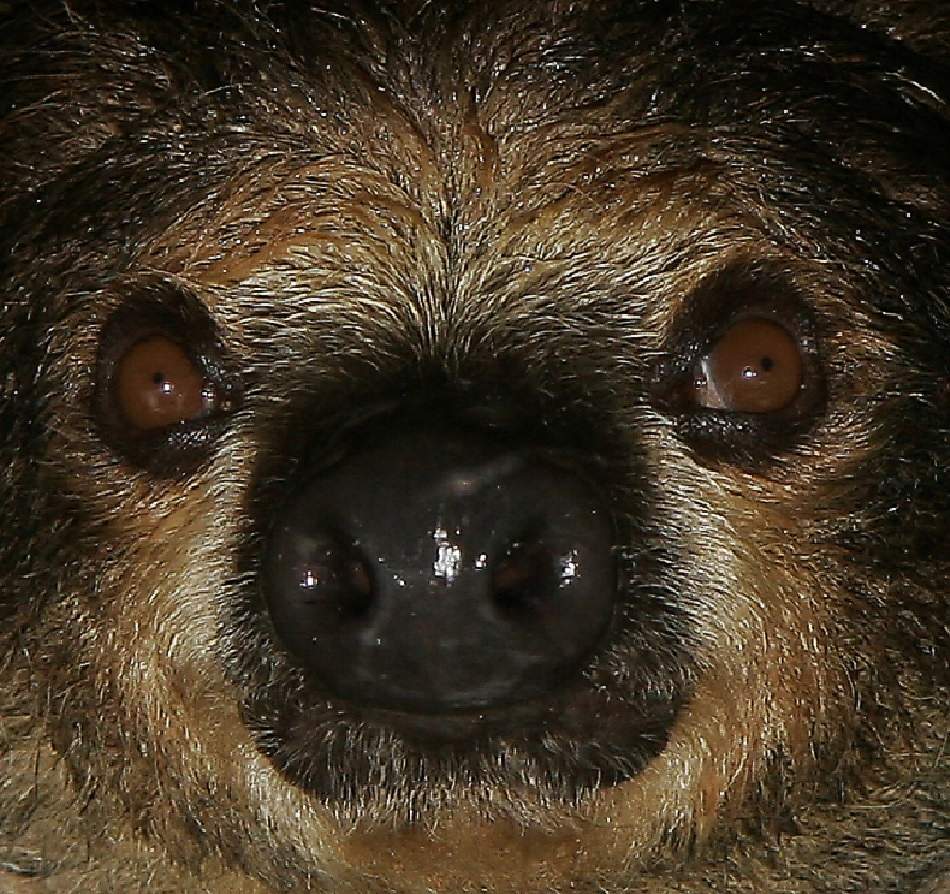sloth Facts
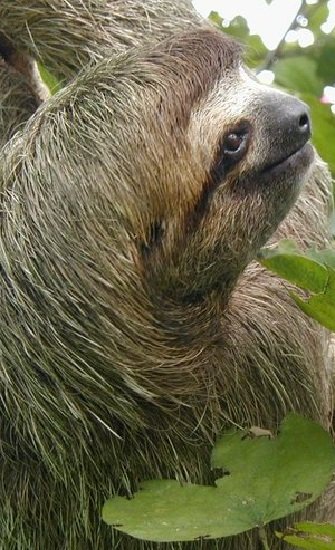 Portrait of an Sloth
Portrait of an SlothThe word "sloth" means "inclined to laziness and inaction", and the amazingly placid and extremely slow moving sloth would certainly appear to live up to its name.
The sloth is almost entirely arboreal, spending over 95 percent of its existence high up in the trees of Central and South America.
With the help of extremely specialized claws, sloths eat, sleep, breed and give birth all while dangling from the tallest branches of cecropia trees. Sloths come in two and three toed varieties and are related to anteaters, who have similarly formed long arching toenails.
Sloths exist on a diet almost entirely of leaves, which is such an inferior source of nutrition and energy that it shapes their whole lifestyle. They end up spending almost every waking moment quietly munching on leaves with little time for grooming or any other activities.
The lack of grooming leads the sloths dense coat to actually grow algae during the rainy season, giving them a greenish tinge.
Within the sloths belly is a sea of micro bacteria that help to breakdown and eventually digest what they eat. The process takes so long that a leaf consumed in August might not be eliminated until October.
With so much effort exerted to extract a minimum of nutrients, the sloths metabolism is amazingly slow- the slowest in the entire animal kingdom. - Sloth Facts
the sloths very special equipment
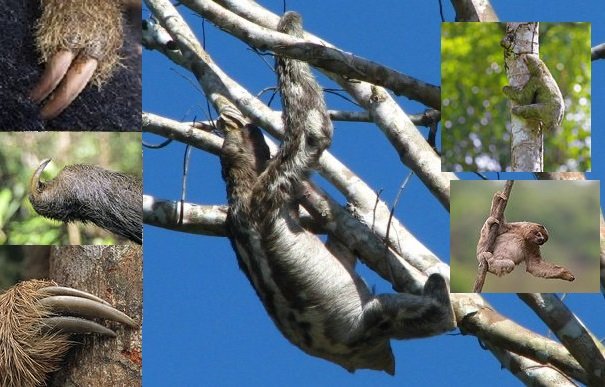
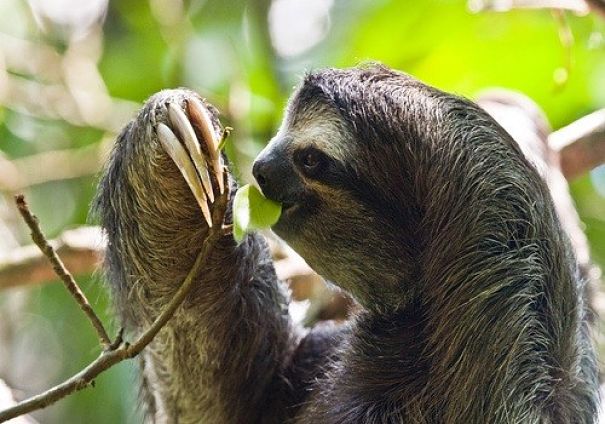
All of the sloth species have numerous amazing adaptions, not only for an arboreal life high in the trees, but also for a life lived in an inverted position.
Sloths do not build nests, instead they find a leafy area and simply fall asleep hanging completely upside down with all four limbs grasping a branch.
Three toed sloths rear legs, feet and claws are shorter than the front and both two-toed and three-toed sloths have three toes on the rear legs.
There is a suggestion that all sloths are three-toed because the front "toes" are actually "fingers".
The claws on the front feet are about 4 inches long, and can be used as a weapon when the sloth is cornered. The claws on all four limbs curve in toward the wrist creating four large, natural hooks. Muscle power is not required for the sloth to grip branches, in fact sloths have about 30% less muscle mass than other mammals of equal size.
It is the construction of the claws and limbs, and a natural retraction of the ligaments that creates the "gripping reflex" of the sloth. A sloth spends approximately 85% of its life hanging completely upside down, mainly because it requires no effort.
The entire sloth is designed for a life of inversion. All of its internal organs, including the heart, liver, spleen and stomach, are rearranged inside its body cavity so nothing gets crushed or obstructed.
Even the fur on the sloths torso and limbs grows in the opposite direction than it would in other animals with the follicles pointing up the arms and away from the belly so the hairs guide rain water and debris to the ground.
As an example of the effortlessness with which sloths dangle from the highest limbs, it is not uncommon for a sloth to pass away and remain securely hooked to its final branch. - Sloth Facts
sloth reproduction
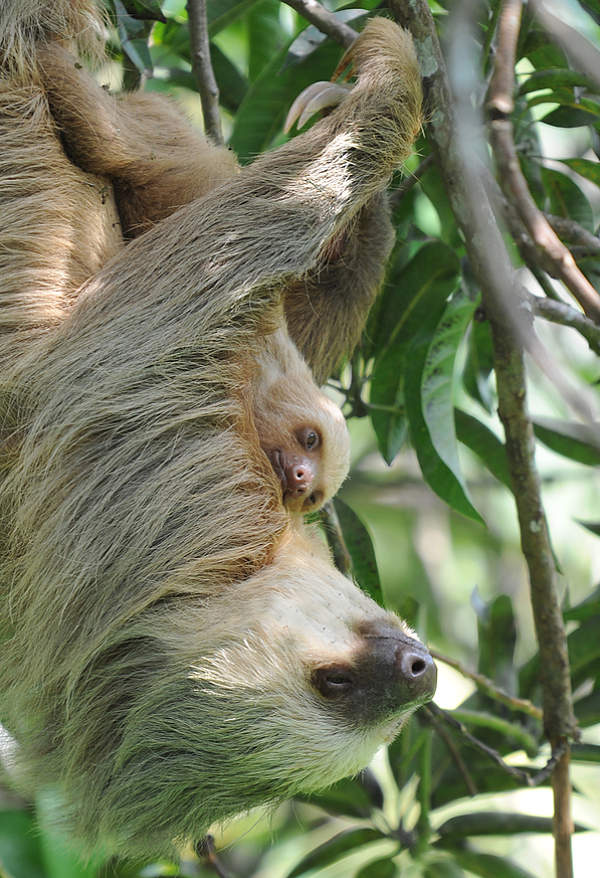 two toed sloth mother and baby
two toed sloth mother and babySo we know that the sloth is incredibly slow. It takes about a month to digest a leaf, about a minute to move 15 feet and about 6 hours to make it to the bathroom and back.
But there is one thing that sloths do with amazing speed, and that one thing is sex.
Sloth females come into heat about once a year and they let the whole neighborhood know it. Normally demure, a lady sloth in heat screams continually until a male finds her or her season passes.
She generally does not leave her own trees and just waits for a suitor to arrive. Then, once a gentleman makes his way up to her, it is basically first come first served without any posturing or foreplay.
In fact, the whole experience from first contact to completion of deed may only be a matter of seconds. In some species the male may stay for a day or two and there may be several matings, but in other species the male departs right after a single 6 second act of intercourse.
The mother sloth gives birth to one pup after about 4 months of pregnancy. The baby is born fully furred, eyes open, and generously clawed. It is basically a miniature adult without the fauna developed in its fur yet, of course.
The pup clings to its mothers belly most of the first few months of life and begins to munch on leaves at about 2 months old.
A baby sloth usually leaves its mother after a year or so, sometimes just moving a tree or two away, but generally has no contact with her once independent. - Sloth Facts

sloth evolution
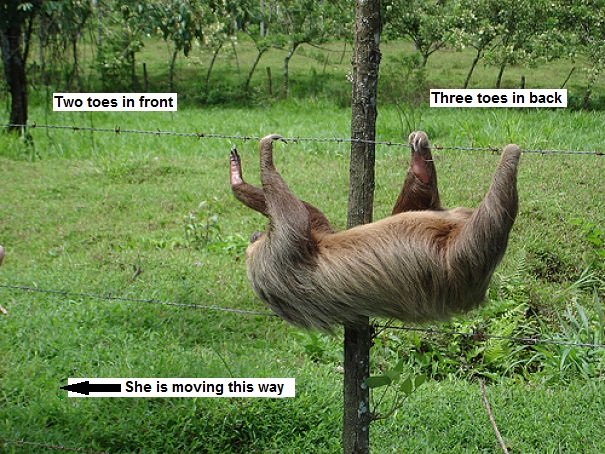 Linnaeus two-toed sloth on a wire
Linnaeus two-toed sloth on a wireSurprisingly, three-toed and two-toed sloths are actually not closely related.
The three-toed and the two-toed sloths are from two different families of animals, with their last known common ancestor having existed over 30 million years ago. That creature, most probably, lived on the ground.
So, although they appear to be very similar, they are better described as animals that evolved in the exact same way due to habitat, rather than being closely related. This is called convergent evolution and is a result of creatures changing in the same ways due to exposure to the same circumstances, and arriving at a very similar result that appears to be more closely related than it actually is.
In fact, the two-toed sloths actual closest relative is the now-extinct ground sloth. The ground sloths, including the gigantic megatherium or giant ground sloth existed throughout the southern United States up till about 10,000 years ago and was larger than an elephant.
These creatures probably lived in groups, as elephants do, and walked on all fours. They had curved claws like the modern sloths and walked on the sides of their feet like anteaters do, because the claws were over a foot long! - Sloth Facts
what's the difference between three-toed and two-toed sloths?
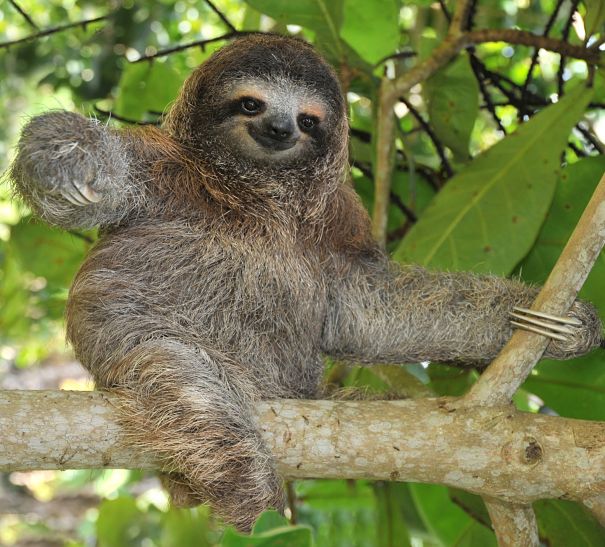 brown-throated three-toed sloth
brown-throated three-toed sloth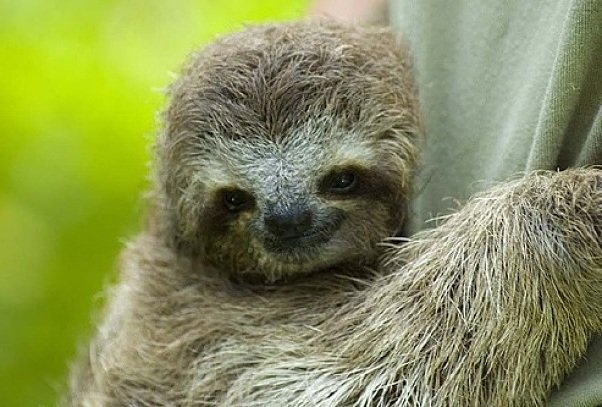 maned three-toed sloth
maned three-toed sloth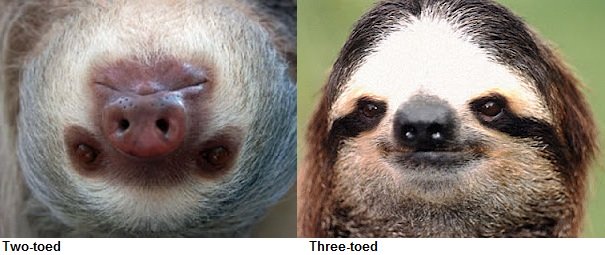
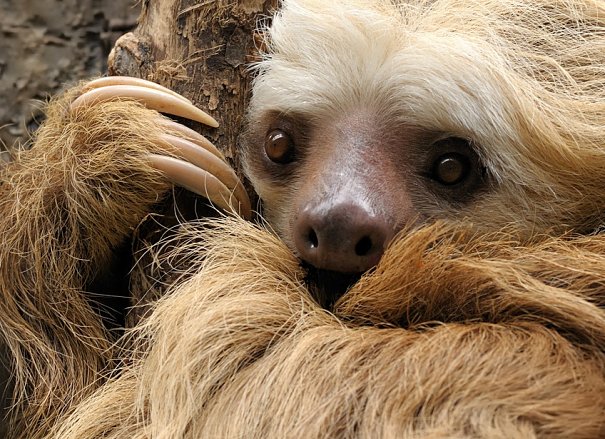 Hoffmanns two-toed sloth (hind foot is also in photo)
Hoffmanns two-toed sloth (hind foot is also in photo)The three-toed sloth is kind of adorable, and has become a bit of an Internet darling. Most of the photos used in wallpapers and t-shirts are of either the brown-throated or pale-throated three-toed sloth.
These two species also have the characteristic dark eye patches that trail down to the neck. Three-toed sloths have fur on their faces, tiny, stumpy tails, three toes on both the front and rear feet, rear legs much shorter than front, and smaller noses than two-toed sloths.
The three-toed sloths also have extra neck vertebrae which allow them to swivel their heads 270 degrees around. Because of major skeletal differences like this, two-toed sloths are in a separate zoological family from three-toed.
Two=toed sloths are larger and faster and eat a more varied diet of fruits and insects along with leaves. This gives them a bit more energy than their smaller relatives, and they move about more freely in a larger range. Two-toeds have bare flesh on their faces, very large, wet noses, no visible tail (there is a tail vertebrae inside the body) and, of course, two toes on the front feet, three on the rear.
Two-toed sloth species are also completely nocturnal, sleeping motionless and almost invisible in the treetops all day long and not moving until after dark. There has been very little field research done on them for this reason, and so, as mysterious an animal as the three-toed sloth is, the two-toed sloth is an even deeper mystery.
Three-toed sloths spend some time active during early morning or dusk so can be observed more easily. The three-toed in particular, has a tremendously mat-like body of thick fur, that it never grooms.
The fur becomes home to both vegetation and insects. Entire colonies of moths may live in their fur, and algae and lichen grow abundantly - particularly in rainy season- providing exceptional camouflage.
Sloths have long, thick, sticky tongues covered in a carpet of tiny, rear-ward pointing spikes that they can pull leaves in with. They have a four-chambered stomach like a cow, to process all the vegetation, but short intestines that don't extract as much energy.
Their bodies do not regulate temperature effectively and they must move to sunny spots to warm up. In cold rainy weather their temperature drops and they become inactive. Cold spells can be dangerous for sloth populations because they must move about to eat, but can't get warm enough to move. - Sloth Facts

sloth lifestyle - pay it forward
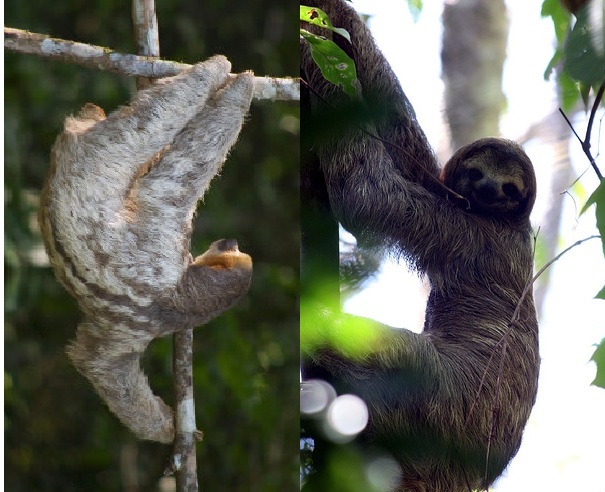
Sloths live in very dense rain forest where the tops of mangrove, cecropia and trumpet trees form the famous "canopy"- a tangle of branches that can allow a creature like the sloth, or other small arboreal animals like monkeys and lizards to travel sometimes for miles across the rain forest, treetop to treetop, without ever touching the ground.
Although their entire range may expand for several trees, there are many sloths, particularly the smaller, less active three-toed species that spend their entire lives in the limbs of just one single large tree.
Once every five to seven days the sloth will climb down to the ground and relieve itself at the base of the tree, burying its feces in basically the same area every time.
The buried stool breaks down quickly and provides excellent fertilizer for the parent tree.
Although it is not known why they risk leaving the tree to defecate and don't simply relieve themselves from a branch, their habit of burying their stool at the roots of the tree they live in is an interesting example of the circle of life. - Sloth Facts.
a few more sloth facts
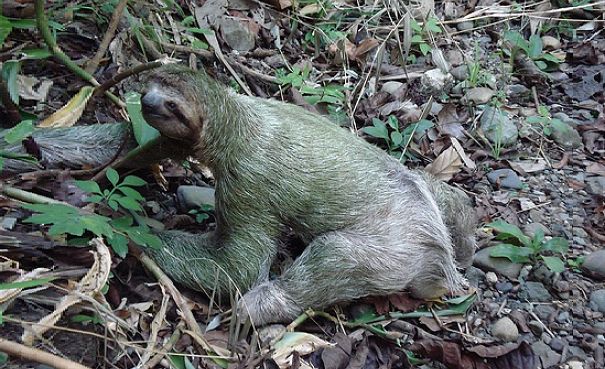 three-toed sloth on the ground
three-toed sloth on the ground- The sloth has the slowest metabolism of any mammal on Earth.
- Sloths take about 25 days to digest one leaf.
- The ancestors of todays sloth were as big as African elephants
- Both two-toed and three-toed sloths have three toes on their hind limbs.
- The sloth takes a potty break only once a week
- Sloths sleep hanging completely upside-down
- The sloths fur is home to algae, lichen and even moths.
- The sloth turns green in the rainy season due to algae growing on its fur. - Sloth Facts
Scientific Classification:
| Sloth Facts - animalstats - | |||
|---|---|---|---|
| MALE | FEMALE | YOUNG | SOCIAL UNIT |
| male | female | pup | solitary |
| GROUP | HOME | LIFESPAN | FAVORITE FOOD |
| bed | Central and South America | 25-35 years | leaves |
| TAIL | AVG. HEIGHT | AVG. LENGTH | AVG. WEIGHT |
| none
or 2 inches |
12 - 20 inches | 19 - 30 inches | 8 - 20 pounds |
| DIFFERENCE BETWEEN 2 and 3 TOED | ENEMIES | ||
| 2-toed larger, faster, nocturnal, lacks tail | jaguar, boa | ||
| TOP SPEED | GESTATION | BIRTHWEIGHT | AT BIRTH: |
| 15ft/minute | 120-150 days | 8 - 9 ounces | sighted,
furred, fully alert |
| RAISED BY | # OF YOUNG | EYES OPEN | BABY CLIMBS |
| mother | 1 | at birth | immediately |
| WEANED | INDEPENDENT | MATURITY | ENDANGERED? |
| 2 - 4 years | 1 year | 2 - 3 years | low concern |
see more animal extreme closeups
Recent Articles
-
African Animals - Animal Facts Encyclopedia
Oct 11, 16 10:27 PM
African Animals facts photos and videos..Africa is a wonderland for animal lovers, and a schoolroom for anyone who wants to learn about nature, beauty and the rhythm of life -
Baboon Facts - Animal Facts Encyclopedia
Oct 11, 16 10:26 PM
Baboon facts, photos, videos and information - Baboons are very distinctive looking monkeys with long, dog-like snouts and close set eyes. -
Great Apes Facts - Animal Facts Encyclopedia
Oct 11, 16 10:25 PM
Great apes facts, photos and videos..Human beings did not evolve from chimpanzees, modern chimps and gorillas do not appear in the fossil records until much more recently than homo sapiens..























